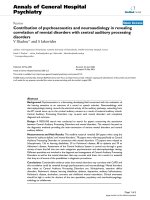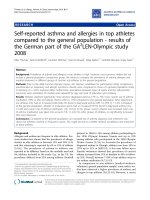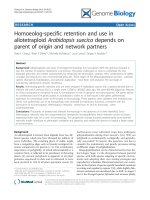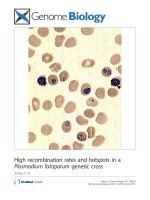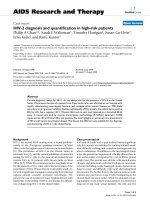Báo cáo y học: "2009 H1N1 Influenza and Experience in Three Critical Care Unit"
Bạn đang xem bản rút gọn của tài liệu. Xem và tải ngay bản đầy đủ của tài liệu tại đây (501.13 KB, 8 trang )
Int. J. Med. Sci. 2011, 8
270
I
I
n
n
t
t
e
e
r
r
n
n
a
a
t
t
i
i
o
o
n
n
a
a
l
l
J
J
o
o
u
u
r
r
n
n
a
a
l
l
o
o
f
f
M
M
e
e
d
d
i
i
c
c
a
a
l
l
S
S
c
c
i
i
e
e
n
n
c
c
e
e
s
s
2011; 8(3):270-277
Research Paper
2009 H1N1 Influenza and Experience in Three Critical Care Units
Turgut Teke
1
, Ramazan Coskun
2
, Murat Sungur
2
, Muhammed Guven
2
, Taha T Bekci
3
, Emin Maden
1
,
Emine Alp
4
, Mehmet Doganay
4
, Ibrahim Erayman
5
, Kursat Uzun
1
1. Selcuk University, Meram Medical Faculty, Pulmonary Diseases and Critical Care Department, 42080, Konya, Turkey
2. Erciyes University Department of Internal Medicine, Division of Critical Care Medicine, 38039, Kayseri, Turkey
3. Konya Educuation Research Hospital Pulmonary Diseases and Critical Care Unit, 42040, Konya, Turkey
4. Erciyes University Department of Infectious Diseases, 38039, Kayseri, Turkey
5. Selcuk University, Meram Medical Faculty, Department of Infectious Diseases, 42080, Konya, Turkey
Corresponding author: Turgut TEKE, Assistant Professor, Selcuk Universitesi Meram Tip Fakultesi Hastanesi, Gogus
Hastaliklari Anabilim Dali, 42080, Meram-Konya/TURKEY. Tel: +90 332 2236218. Fax: +90 332 3237121; E-mail: turgut-
© Ivyspring International Publisher. This is an open-access article distributed under the terms of the Creative Commons License (
licenses/by-nc-nd/3.0/). Reproduction is permitted for personal, noncommercial use, provided that the article is in whole, unmodified, and properly cited.
Received: 2011.01.24; Accepted: 2011.04.04; Published: 2011.04.07
Abstract
Aim: We describe futures of ICU admission, demographic characteristics, treatment and
outcome for critically ill patients with laboratory-confirmed and suspected infection with the
H1N1 virus admitted to the three different critical care departments in Turkey.
Methods: Retrospective study of critically ill patients with 2009 influenza A(H1N1) at ICU.
Demographic data, symptoms, comorbid conditions, and clinical outcomes were collected
using a case report form.
Results: Critical illness occurred in 61 patients admitted to an ICU with confirmed (n=45) or
probable and suspected 2009 influenza A(H1N1). Patients were young (mean, 41.5 years),
were female (54%). Fifty-six patients, required mechanical ventilation (14 invasive, 27 non-
invasive, 15 both) during the course of ICU. On admission, mean APACHE II score was
18.7±6.3 and median PaO
2
/FIO
2
was 127.9±70.4. 31 patients (50.8%) was die. There were no
significant differences in baseline PaO
2
/FIO
2
and ventilation strategies between survivors and
nonsurvivors. Patients who survived were more likely to have NIMV use at the time of ad-
mission to the ICU.
Conclusion: Critical illness from 2009 influenza A(H1N1) in ICU predominantly affects
young patients with little major comorbidity and had a high case-fatality rate. NIMV could be
used in 2009 influenza A (H1N1) infection-related hypoxemic respiratory failure.
Key words: 2009 influenza A(H1N1); ARDS; critical care units; mechanically ventilation; mortality
INTRODUCTION
In 2009, cases of influenza like illness were first
reported in Mexico on March 18; the outbreak was
subsequently confirmed as H1N1 influenza. A Novel
H1N1 swine origin influenza virus has led to a
worldwide pandemic (1). In the affected patients, a
novel swine origin influenza A (H1N1) virus (S-OIV)
with molecular features of North American and Eur-
asian swine, avian, and human influenza viruses were
isolated (2). In the same month, the World Health
Organization (WHO) classified the global spread of
this virus as a public health event of international
concern. After documentation of human to human
transmission of the virus in at least three countries of
two WHO regions, the WHO raised the pandemic
Int. J. Med. Sci. 2011, 8
271
level to 6 (3). It has spread very rapidly since the first
cases were diagnosed in Mexico with the subsequent
spread of the virus throughout Europe during the
winter season. The H1N1 2009 influenza pandemic
(pH1N1) has resulted in over 15921 deaths worldwide
more than 212 countries as of 14 February 2010 (4).
Turkey reported its first laboratory-confirmed case of
influenza A (H1N1) on 16 May 2009, becoming the
eighteenth country in the WHO European region to
do so, and a second case on 17 May 2009 (5).
The clinical picture in severe cases of pandemic
(H1N1) 2009 influenza is markedly different from the
disease pattern seen during epidemics of seasonal
influenza, in that many of those affected were previ-
ously healthy young people. Current predictions es-
timate that, during a pandemic wave, 12-30 % of the
population will develop clinical influenza (compared
with 5-15% for seasonal influenza) with 4% of those
patients requiring hospital admissions and one in five
requiring critical care (6).
Pandemic Influenza A (H1N1) virus infection is
the first pandemic in which intensive care units (ICU)
play a fundamental role. During the pandemic, a sig-
nificant number of patients became critically ill pri-
marily because of respiratory failure. Most of these
patients required intubation and mechanical ventila-
tion (7).
In this report, we describe futures of intensive
care unit admission, demographic characteristics,
treatment and outcome for critically ill patients with
laboratory-confirmed and suspected infection with
the H1N1 virus admitted to the three different critical
care departments during winter of 2009 in Turkey.
MATERIAL AND METHODS
In response to an outbreak of influenza A virus
infection in Mexico, Turkish Ministry of Health de-
veloped a case report form. The patients were admit-
ted to hospital and critical care units according to this
case report form. Data were collected retrospectively
on all patients who had influenza A 2009 related crit-
ical illness from November 1 2009 to December 15
2009. Ethical approval was provided from the Ethics
Committee of Meram Medical Faculty, Selcuk Uni-
versity, Konya, Turkey.
Influenza-like illness (ILI) is defined as fever,
cough, and headache, accompanied by one or more of
the following signs or symptoms: rhinorrhea, coryza,
arthralgia, myalgia, prostration, odynophagia, chest
pain, abdominal pain, and nasal congestion.
Data were reported by the attending physicians
reviewing medical charts, radiologic and laboratory
records. The following information was recorded;
demographic data, comorbidities, time from illness
onset to hospital admission, time to first dose of anti-
viral delivery, microbiologic findings, and chest radi-
ologic findings at ICU admission. Intubation and
mechanical ventilation requirements, adverse events
during ICU stay and laboratory findings at ICU ad-
mission were also recorded.
We classified patients according to case defini-
tions (confirmed, probable, or suspected) developed
by the World Health Organization and Centers for
Disease Control and Prevention. A confirmed case of
novel influenza A (H1N1) virus infection is defined as
a person with an ILI with laboratory confirmed novel
influenza A (H1N1) virus infection by real time
RT-PCR (8, 9).
We defined critically ill patients as those admit-
ted to an adult intensive care unit (ICU); requiring
mechanical ventilation or receiving intravenous infu-
sion of inotropic or vasopressors during the hospital-
ization. Severity of illness was assessed in adults us-
ing the Acute Physiology and Chronic Health Evalu-
ation (APACHE) II within 24 hours of ICU admission.
We recorded co-morbidities and prior defined major
co-morbidities as the presence of one or more of the
following chronic medical conditions: asthma, chronic
obstructive pulmonary diseases (COPD), congestive
heart failure, malignancy, neuromuscular disorders,
cerebral palsy, diabetes mellitus, coronary artery dis-
eases, heart diseases, chemotherapy, malnutrition,
immunosuppressive status or renal failure.
Nasopharyngeal-swab specimens were collected
at admission, and bronchial-aspirate samples were
obtained after tracheal intubation. Specimens were
placed in transport medium and kept at a temperature
from 2 to 4°C. RT-PCR testing was done in accordance
with published guidelines from the U.S. Centers for
Disease Control and Prevention (CDC) (10). Seasonal
vaccination history and radiographic findings were
recorded to study form. Specimens (bronchoalveolar
lavage and blood) for culture sent to microbiology
laboratory for detection of bacterial infection in inva-
sive and noninvasive mechanically ventilated pa-
tients. The body-mass index (BMI, weight in kilo-
grams divided by the square of the height in meters)
was calculated. Obesity defined as a BMI 30 to 40 in
patients. Morbid obesity defined as BMI > 40.
Statistical analysis; Descriptive analysis included
frequency (%) and mean ± standard deviation (SD).
Mann-Whitney Test used for significance in between
groups. We accepted P value <0.05 for significance.
RESULTS
During the study period which is November 1
2009 to December 15 2009, 61 critically ill patients
were admitted to three different critical care units in
Int. J. Med. Sci. 2011, 8
272
Turkey due to confirmed or suspected influenza A
2009 (H1N1) infection were assessed. In 45 patients,
diagnosis was confirmed by real-time PCR for pan-
demic H1N1 virus. In 16 patients, diagnosis was sus-
pected according to CDC and WHO criteria (8, 9).
Average age was 41.52 ± 15.7 years and, 54 % were
female (female: 33, male: 28). Mortality rate was 50.8
% (31 patients). Mortality rate in males was 64.3% and
in females 39.4% (p >0.05) Clinical characteristics of
patients with influenza A virus infection were showed
in Table 1, Table 2 and Table 3. In Table 4 comparison
between survivors and nonsurvivors were shown.
Table 1. Characteristics of the patients with Influenza A (H1N1) virus in critical care unit
Variable Value (mean±SD)
Female sex, n(%) 33 (54.1)
Age 41.52±15.7
Physical examination
Respiratory rate 34.3±10.2
Mean arterial blood pressure 90.3±18.3
Heart rate 113.2±19.4
Obesity, n (%) 17 (27.9%)
BMI, 30 to 40 13 (21.3%)
BMI, >40 4(6.6%)
Underlying diseases, n (%)
Asthma 5 (8.1%)
COPD 9 (14.7%)
Pregnancy 3 (4.9%)
Neuromuscular 5 (8.1%)
Serebrovascular diseases 3 (4.9%)
Malignancy 6 (9.8%)
Arterial hypertension 8 (13.1%)
Diabetes mellitus 8 (13.1%)
Coronary artery diseases 5 (8.1%)
Chronic renal failure 6 (9.8%)
Immunosupression 4 (6.5%)
Chronic heart failure 7 (11.4%)
Table 2. Laboratory findings of the patients with Influenza A (H1N1) virus in critical care unit
Variable Value (mean±SD)
Laboratory findings
Leukocyte count, per mm
3
8.73±6.95
Lymphocyte count, per mm
3
0.76±0.57
Serum creatine kinase, U/L 418.7±529.1
Serum lactate dehydrogenase, U/L 604.8±316.9
Serum creatinin (mg/dL) 1.6±1.8
AST (U/L) 96.8±145.3
ALT (U/L) 45.6±70
Platelets count (per mm
3
) 188.8±108.4
Opacity on initial chest X-ray, n (%)
Normal chest X-ray 2 (3.2%)
Bilateral infiltrates on chest X-ray 55 (90.1%)
1/4 quadrants infiltrates on chest X-ray 1 (1.7%)
2/4 quadrants infiltrates on chest X-ray 10 (17.2%)
3/4 quadrants infiltrates on chest X-ray 7 (12%)
4/4 quadrants infiltrates on chest X-ray 40 (69%)
Int. J. Med. Sci. 2011, 8
273
Table 3. Clinical Course and Outcomes of Patients with Influenza A (H1N1) virus in critical care unit
Variable Value (mean±SD)
APACHE II score 18.7±6.3
Days from onset symptoms to ICU admission, 7.4±4.17
Days from onset symptoms to first antiviral dose 7.09±4.24
Mechanical ventilation on admission, n (%)
NIMV 42 (68.8%)
IMV, total n (%) 29 (45.9%)
IMV, on admission n (%) 14 (23%)
Intubation and IMV after NIMV 15(24.5%)
Death n (%) 31(50.8%)
The length of critical care stay (days) 8.4±5.68
The length of hospital stay (days) 12.2±8.1
NIMV: Noninvasive mechanical ventilation, IMV: Invasive mechanical ventilation
Table 4. Comparison of survivors and nonsurvivors
Patient characteristic Survivors
(n:30) (Mean±SD)
Nonsurvivors
(n:31)
(Mean±SD)
p value
Age, years 38.2±12.9 44.1±17.7 ns
Female sex, n (%) 20 (66.6) 13 (41.9) ns
Comorbidities, n (%) 26 (86.6) 24 (77.4) ns
BMI 28.1±5.3 27.4±8.5 ns
Obesity, n (%) 10 (33.3) 7 (22.6) ns
APACHE II score 16.5±5.4 20.9±6.5 0.007
PaO
2
/ FiO
2
(mmHg) 136.6±75.7 120.1±65.6 ns
Initial MAP (mmHg) 94.8±15.8 85.9±19.9 ns
Days from onset symptoms to ICU admission, 7.73±4.29 7.39±3.96 ns
Days from onset symptoms to first antiviral dose, 7.3±4.46 7.19±3.94 ns
Mechanical ventilation on admission, n (%)
NIMV 25(83.3) 17(54.8) 0.016
IMV, total 8(26.7) 20(64.5) 0.003
IMV, on admission 1(3.3) 13(41.9) 0.0005
Intubation and IMV after NIMV 7(23.3) 8(25.8) ns
Duration of IMV 6.36±6.5 5.9±5.5 ns
Duration of NIMV 4.0±3.4 3.3±3.8 ns
Ventilation settings, (mean±SD)
Tidal volume per ideal body weight, mL/kg 6.6±1.3 6.4±1.2 ns
Plateau pressure. cmH
2
O 27.9±6.5 31.4±7.1 ns
Set PEEP, cmH
2
O 8.8±5.4 16.4±4.2 0.001
Organ dysfunction
Creatinine, mg/dL 1.38±1.37 1.84±2.17 ns
AST, U/L 70.4±87.2 90.1±69.7 ns
Platelet count, 103/µL 193.1±87.2 185.0±125.9 ns
Bilirubin, mg/dL 0.85±0.90 1.06±0.97 ns
Creatinin kinase, U/L 314.0±372.9 527.8±644.1 ns
NIMV: Noninvasive mechanical ventilation, IMV: Invasive mechanical ventilation
Symptoms at presentation included fever (88.5
%), cough (83.6 %), sputum (79 %) and dyspnea
(96.7%). Diarrhea, nausea, and vomiting were re-
ported in 24.6 %, 39.3 %, and 45.9 %, respectively. The
mean time from the onset of illness to critical care
admission was 7.56 ± 4.1 days (range, 2 to 22). Un-
derlying medical condition was existed in 50 (82 %)
patients. Obesity (27.9 %) and COPD (14.7 %) were the
most common conditions in patients. There was no
significant difference according to underlying medical
condition in between nonsurvivor and survivor
groups. A total of 3 patients (4.9%) were pregnant, of
Int. J. Med. Sci. 2011, 8
274
whom 2 had another underlying medical condition
(asthma and heart disease). Of the 4 pregnant pa-
tients, 1 was in the first trimester, 1 was in the second
trimester, 1 was in the third trimester, and 1 was in the
postpartum period.
At the time of ICU admission, all patients had
elevated lactate dehydrogenase levels (604.8 ± 316.9
U/L), 25 (40.9 %) above 500 U/L, and 7 (11.4 %) above
1000 U/L. Thirty-three patients (54%) had elevated
aspartate aminotransferase (144.5 ± 178.07 U/L).
Thirteen patients had elevated alanine aminotrans-
ferase (121.2 ± 127.5 U/L). Sixteen patients (26%) had
increased creatinin kinase levels (mean 418.7 ± 529.1
U/L) (range, 6 to 2573 U/L). C-reactive protein was
measured in 48 patients (78.7%) with a mean of 95.1 ±
49.5 mg/dL. Eighteen patients (24.6 %) had elevated
creatinine levels (>1.2 mg/dL) at hospital admission.
On admission, 11 of 61 (18 %) patients who were
tested had leukopenia, 27 of 61 (42.2 %) had anemia,
and 18 of 61 (29.5 %) had thrombocytopenia. Twelve
of 61 patients had positive blood and bronchoalveolar
lavage cultures.
Of the 61 patients, all of them received oselta-
mivir. The mean time from the onset of illness to the
initiation of antiviral therapy was 7.4±4.17 days
(range, 1 to 22 days); 2 of the patients received anti-
viral therapy within 48 hours after the onset of
symptoms. Antiviral therapy was started before ad-
mission in 4 patients, on admission in 55 patients,
within 48 hours after admission in 2 patients. There
was significant difference according to the time from
the onset of illness to the initiation of antiviral therapy
between nonsurvivors and survivors (p<0.05). Initia-
tion time of antiviral treatment was earlier in survi-
vors compared to nonsurvivors. All patients received
antibiotics. Antibiotic therapy was started before ad-
mission in 32 patients and on admission in 29 patients.
Patients received a mean of two different antibiotics
(range, one to five); 81% of the patients received more
than one antibiotic. Commonly used antibiotics in-
cluded moxifloxacin (in 19 patients), linezolid (in 14
patients), ampicilline-sulbactam (in 13 patients), clar-
ithromycin (in 13 patients), piperacillin-tazobactam
(in 12 patients), imipenem (in 11 patients), third gen-
eration cephalosporin (in 9 patients), vancomycin (in 2
patients), teicoplanin (in 4 patients), and tigecycline
(in 8 patients).
Of 61 patients for whom data were available
regarding the use of corticosteroids, 20 (32.8 %) re-
ceived intravenous steroids. Of the patients who re-
ceived corticosteroids, 85 % had an underlying med-
ical condition; the most common conditions were
COPD and asthma (70%). Chest radiograph findings
were abnormal in 55 patients. Radiographic findings
including bilateral infiltrates were existed in 55 pa-
tients on admission. Patients with viral primary
pneumonia had bilateral patchy alveolar opacities,
affecting two or five quadrants in 51 patients.
All patients had a mean oxygen saturation of
65% (range, 45 to 80) in the absence of supplementary
oxygen. After supplementary oxygen, all patients had
a mean oxygen saturation of 83.7 % (range, 49 to 98).
Mean APACHE II score was 18.7 ± 6.3 (range, 6
to 37). All patients had gas exchange abnormalities on
admission. PaO
2
/FiO
2
ratio was 127.9±70.4 (range, 34
to 420). ARDS was diagnosed in 48 patients (78.6 %)
and ALI in 4 (6.5 %) of the patients. Clinical evidence
of bacterial infection on ICU admission was present in
7 patients (11.4 %).
Data on the use of mechanical ventilation in the
ICU were available for all patients. Non-invasive
mechanic ventilation was performed in 42 patients.
Fifteen of these patients were endotracheally intu-
bated after a mean of 3.4 ± 1.7 days. Fourteen patients
initially received invasive mechanically ventilation.
Thirty (49.2 %) patients survived to hospital dis-
charge. APACHE II score was higher in nonsurvivors
(20.9 ± 6.7) than survivors (16.5 ± 5.4) (p<0.01). There
were 8 obese patients in nonsurvivor group and in 7
obese patients in survival group (p>0.05). In 3th days,
mean level of urea, creatinine, international normal-
ized ratio (INR) and heart rate were higher nonsur-
vivors than survivors (p<0.05, p<0.05, p<0.05, and
p<0.01). PaO
2
/FiO
2
ratio was lower in nonsurvivors
than survivors in third ICU day (p<0.05). Renal failure
began in third ICU day. Renal failure developed in 10
patients and 6 of them died.
Patients divided into two groups according to
type of mechanical ventilatory support. Of all pa-
tients, 56 (91%) were mechanically ventilated on the
first day of ICU admission; 14 (23 %) patients received
invasive and 42 (68.8 %) noninvasive mechanical ven-
tilation. Fifteen patients (24.5 %) who received non-
invasive ventilation ultimately required invasive ven-
tilation. Full-face mask was used in all patients for
NIMV. APACHE II score, PCO
2
, white blood cell
count and neutrophil account were higher in invasive
mechanical ventilation group than NIMV group. Ar-
terial blood pH was lower in invasive mechanical
ventilation group than NIMV group. Duration of
NIMV and IMV were 5.28 ± 3.4 days (range, 2 to 14)
and 6.92 ± 5.8 days (range, 1 to 19) respectively. In
survivors, the length of invasive mechanical ventila-
tion ranged from 1 to 19 days (6.2 ± 5.5days). The
length of NIMV ranged from 1 to 14 days (4.25 ± 3.8
days). There were no significant differences in tidal
volume or ventilation strategies between survivors
and nonsurvivors. Patients who survived were more



